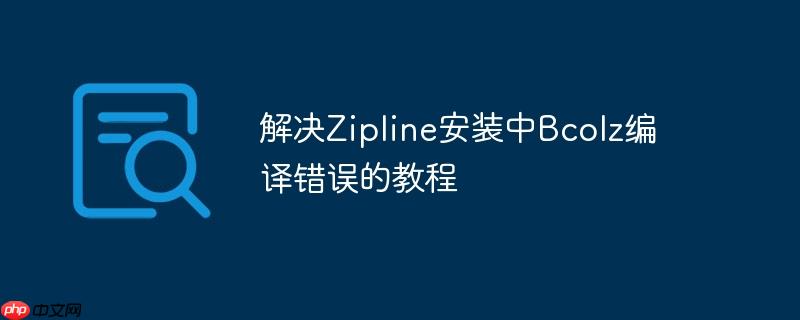
摘要
在尝试安装Zipline时,你可能会遇到Bcolz编译失败的问题,这通常是由于Cython版本过高或者pip安装方式不当引起的。本文将指导你如何通过降低Cython版本到0.28,并使用get-pip.py安装pip,来解决这个问题。此外,如果遇到blosc Error,更换基础镜像也是一个可行的解决方案。遵循本文的步骤,可以帮助你成功安装Zipline,并开始你的量化回测之旅。
解决方案
在构建docker镜像或者进行本地安装时,如果遇到类似 “Building wheel for bcolz (setup.py): finished with status ‘error'” 的错误,这通常意味着Bcolz的编译过程出现了问题。Bcolz是Zipline依赖的一个重要库,用于高效地存储和处理大量数据。以下是一些解决此问题的步骤:
1. 降低Cython版本
较新版本的Cython可能与Bcolz的编译过程不兼容。将Cython版本降低到0.29以下通常可以解决此问题。推荐使用0.28版本。
pip install cython==0.28
2. 使用get-pip.py安装pip
避免使用系统自带的pip,而是使用get-pip.py脚本安装pip。这样可以确保pip的版本是最新的,并且可以避免一些潜在的兼容性问题。
首先,下载 get-pip.py 脚本。
然后,使用Python运行该脚本进行安装。
python get-pip.py
注意: 确保替换URL中的3.6为你的Python版本。
3. 安装其他依赖
在安装Bcolz之前,建议先安装一些其他的依赖库,例如setuptools-scm和numpy。
pip install setuptools-scm numpy
4. 安装Bcolz
在完成上述步骤后,尝试安装Bcolz。在 requirements.txt 文件中,只保留 bcolz 即可,不需要指定版本。
pip install -r requirements.txt
或者,直接使用pip安装:
pip install bcolz
5. 解决Blosc错误 (可选)
如果在安装过程中遇到 blosc error: conflicting types for ‘_xgetbv’ 错误,这通常是由于基础镜像中某些库的版本冲突引起的。解决这个问题的方法是更换基础镜像。例如,你可以尝试使用更基础的Python镜像,或者选择一个已经预装了必要依赖的镜像。
在Dockerfile中修改 FROM 指令,例如:
FROM python:3.6-slim
或者
FROM ubuntu:18.04 RUN apt-get update && apt-get install -y python3 python3-pip
注意: 更换基础镜像后,可能需要重新安装一些依赖库。
完整示例 (Dockerfile)
以下是一个完整的Dockerfile示例,展示了如何应用上述解决方案:
FROM python:3.6-slim WORKDIR /app COPY requirements.txt /app/ RUN apt-get update && apt-get install -y --no-install-recommends build-essential RUN curl "https://bootstrap.pypa.io/pip/3.6/get-pip.py" -o "get-pip.py" RUN python get-pip.py RUN pip install cython==0.28 RUN pip install setuptools-scm numpy RUN pip install -r /app/requirements.txt # 其他配置... ENTRYPOINT ["python"]
requirements.txt 文件内容:
bcolz zipline # 其他依赖...
注意事项
-
版本兼容性: 在安装Zipline及其依赖时,务必注意版本兼容性。Zipline对Python版本和依赖库的版本都有一定的要求。
-
错误信息: 仔细阅读错误信息,可以帮助你快速定位问题所在。
-
清理缓存: 在尝试多次安装失败后,可以尝试清理pip缓存,以避免缓存导致的问题。
pip cache purge
-
虚拟环境: 建议在虚拟环境中安装Zipline,以避免与系统环境中的其他库产生冲突。
总结
通过降低Cython版本,使用get-pip.py安装pip,以及更换基础镜像(在必要时),可以有效解决Zipline安装过程中Bcolz编译错误的问题。希望本教程能够帮助你成功安装Zipline,并顺利开展量化回测工作。


评论(已关闭)
评论已关闭